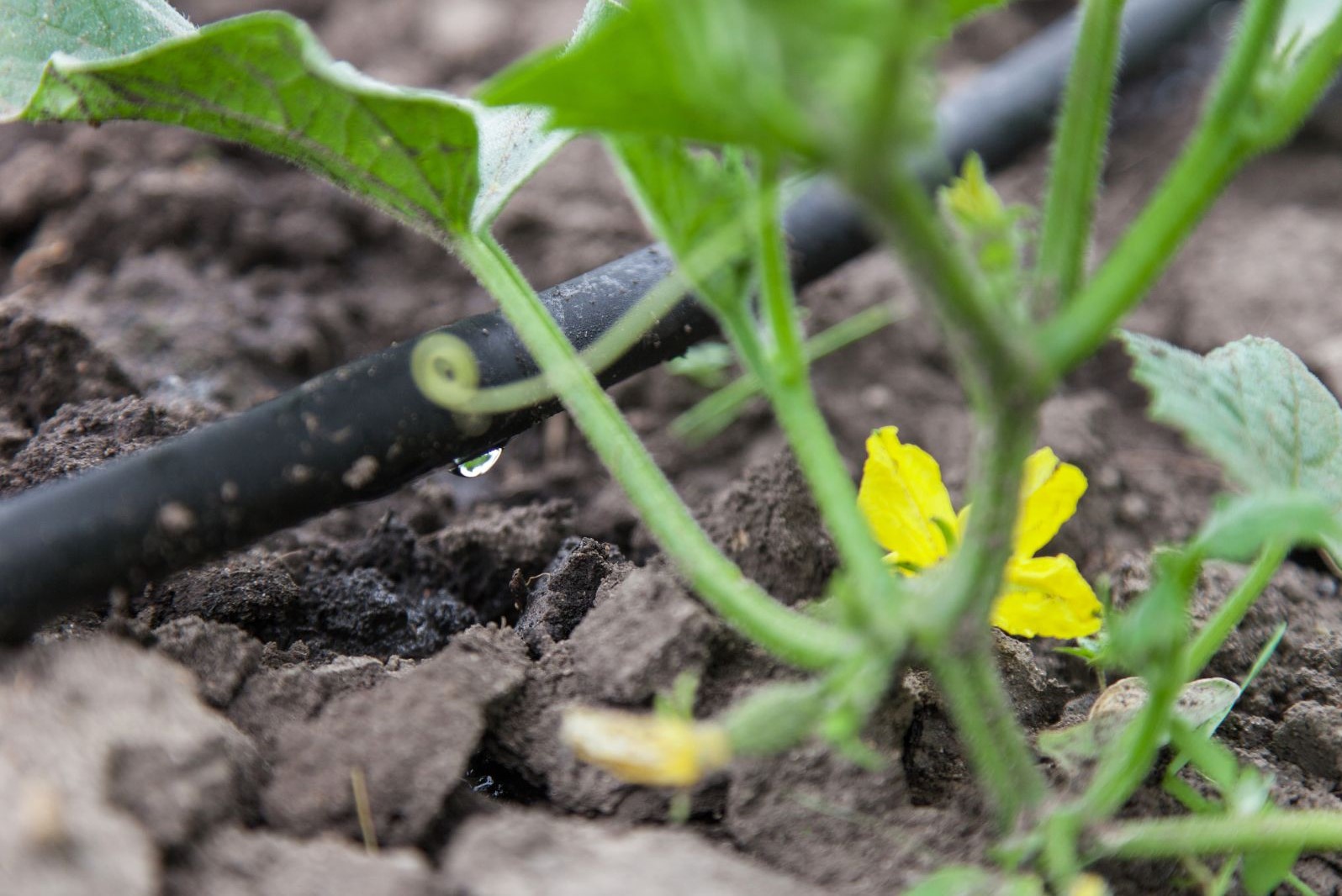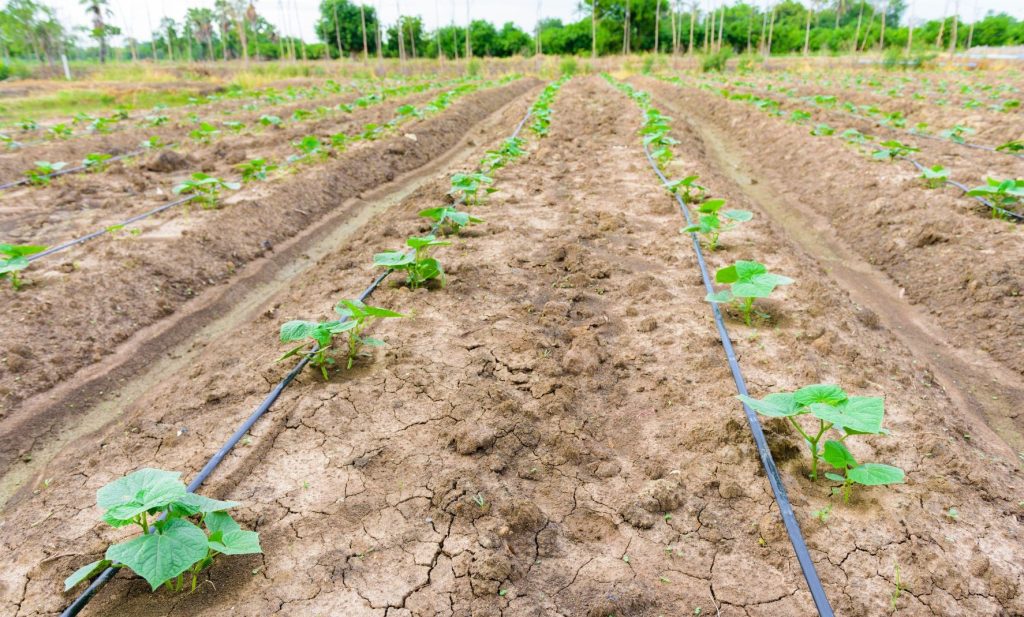Cucumber Irrigation – Water Requirements and Methods

This post is also available in:
This post is also available in:
![]() Español (Spanish)
Español (Spanish) ![]() Français (French)
Français (French) ![]() Deutsch (German)
Deutsch (German) ![]() हिन्दी (Hindi)
हिन्दी (Hindi) ![]() Ελληνικά (Greek)
Ελληνικά (Greek)
Cucumber irrigation requirements – How much water do cucumbers need?
It is well known that many crops need adequate soil moisture to have vigorous growth and high yields. Cucumbers can suffer from drought especially when there is a lack of water or soil moisture for extended periods since the plants have a shallow root system (3). Such drought stress can lead to a quality reduction of the cucumber fruits that become bitter, more pointy at the edges, and misshaped.
More specifically, cucumbers need moderate moisture levels, because their more intense growth takes place early in the season. In case rainfalls cannot cover the crop’s needs, extra irrigation is required. The exact amount of water that cucumber cultivation needs depends on a variety of factors, such as local climate conditions, the quality of soil, and the method of irrigation applied. During the growing period, the farmer has to irrigate the cucumbers frequently. In case of insufficient irrigation and, thus, moisture, fruit shape will be affected, whereas water-soaked fields will trigger mildew and other disease problems (2). According to Oklahoma State University, an adequate amount of water for cucumber cultivation is around 3.8 cm (1.5 inches) of water every 7 to 10 days during the hottest months of the summer (1). Other sources confirm that a cucumber plant needs 2.5–5 cm (1–2 inches) of water per week. Generally, it is recommended to provide a fixed amount of water after planting and increase it when cucumbers start to bloom. In other words, watering in spring can take place every 2-3 days, while in summer 4-6 days on a weekly basis. To maintain good soil moisture, many farmers (especially when drip irrigation is applied), use mulch around the plants. It is important to keep the soil wet at a depth of at least 15 cm (6 inches). You have also to keep in mind that to prevent diseases, you have to water the base of the plant (early in the morning) and avoid wetting the foliage (3).
Cucumber irrigation methods – Which is the best irrigation system for cucumbers?
In general, cucumber is irrigated with overhead sprinklers, furrow irrigation (flooding furrows), and drip irrigation systems (direct drip lines along the planted rows) (1, 2). However, drip irrigation is by far the most common irrigation method used in cucumbers both for open fields and greenhouse cultivations.
Drip irrigation systems are often used when the water volume or the pressure is low. Drip systems are very efficient since water is either applied to the surface of the soil or the subsurface with buried drip tape. Drip irrigation is characterized by some other advantages as well. More specifically, there is the capacity to carry out other operations on the field at the same time, not wetting the crop foliage (reducing crop disease pressure), and being able to use the drip system for applying the fertilizer. This system is known as fertigation (1). It has been found that in drip irrigation, the percentage of the fruit of pickling size is higher, and the non-marketable yield is lower. This system is also more efficient than sprinkler irrigation. On all cases water’s electrical conductivity has to be below 1,7 dS-1 (4). Generally, irrigation contributes to total sugar and vitamin C losses, but there is no difference between drip and sprinkler irrigation (Spizewski and Knaflewski, 2009).
In non parthenocarpic varieties, pollination is needed for fruit formation. As a result, pollination should not be prevented in no case, and it is recommended not to apply an overhead sprinkler irrigation system between sunrise and 11:00 a.m. during the flowering and fruit-setting period, since this may prevent bees from pollinating the flowers. When this type of irrigation is used, water operations should take place early in the morning, so leaves can dry before nightfall to reduce the incidence of fruit rot and foliar diseases. This doesn’t apply during pollination (1).
References
- https://extension.okstate.edu/fact-sheets/cucumber-production.html
- https://www.wifss.ucdavis.edu/wp-content/uploads/2016/10/Cucumbers_PDF.pdf
- https://hgic.clemson.edu/factsheet/cucumber/
- https://www.aua.gr/ekk/
- Spizewski, T., Knaflewski, M. (2009) THE EFFECT OF IRRIGATION METHODS ON THE YIELD OF PICKLING CUCUMBER, Poznan
Further reading
Cucumber History, Plant Information, Interesting facts, and Nutritional Value
How to grow cucumber for profit – Commercial cucumber cultivation
Principles for selecting the best Cucumber Variety
Cucumber Soil preparation, Soil, and Climate requirements, and Seeding requirements
Cucumber Irrigation – Water Requirements and Methods
Cucumber Fertilization Requirements and Methods
Weed Management in Cucumber Farming








































































